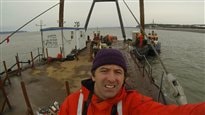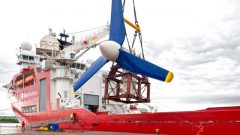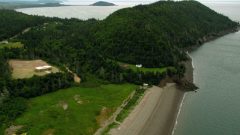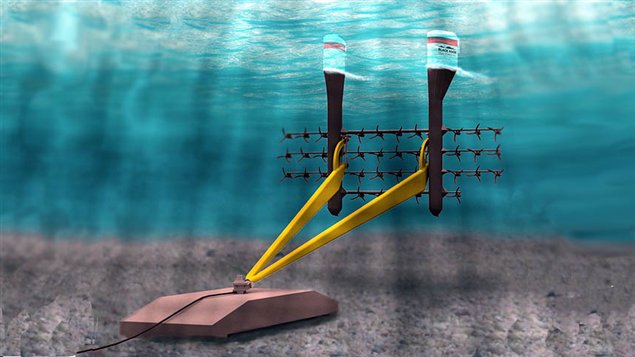As more is understood about global warming and man’s affect on the changing climate, more sources of renewable energy are sought to reduce our output of greenhouse gas.
One of those potential sources is harnessing the power of the tides.
Matthew Lumley is Communications Director at the Fundy Ocean Research Centre for Energy (FORCE
ListenFORCE is a not-for-profit organization made up of public and private developers, regulators, scientists and academics.

For the past few years it has been mapping the seafloor and preparing to test four subsea turbines (that operate somewhat like underwater windmills) at its demonstration facility in the Minas Passage, 10 kilometres west of Parrsboro in the Bay of Fundy in Canada’s east coast province of Nova Scotia.
The Bay of Fundy has the highest tides in the world. and with each advance and ebb of the tides, about 14 billion tons of water go through the Minas passage.

The first OpenHydro turbine tested in 2009-10 showing scale with the two engineers at lower left. The vanes of this stationary turbine rotate clockwise or counterclockwise depending on direction of the tide. (CLICK to ENLARGE)
What’s more important however is that the flow is squeezed through the passage, which acts like a venturi and the water speeds up to get through. In this case the flow increases from one metre/second before and after the narrows, to up to 5m/sec at peak velocity through the passage.
As the speed increases, there is a vast increase in power: for example, a doubling of speed translates into eight times greater power.
Matt Lumley says the potential power in the Minas Passage is in the order of seven thousand megawatts, with about 2,500 MW extractable without causing any environmental issues.
He points out the entire peak consumption of the province of Nova Scotia is about 2000 MW.

Another technology is more familiar, looking like an airplane propeller (Atlantis) (CLICK to ENLARGE)
Unlike some concepts which harness power with dams to create a resource of potential energy, what FORCE is doing is trying to use the kinetic energy by placing in-stream generators, placing them on the seabed.
He notes that one of the first technologies to generate power from the tides had its blades blown out by the force of the spring tide. However, as they learn more about the currents in the passage, the developers that are testing prototypes in the current are better able to design their turbines to withstand the forces and other conditions

Aerial view of the Fundy shore with the FORCE centre in clearing at left. Buried cables under the land will be fed by cables on the seafloor connected to the generators out in the current. (CLICK to ENLARGE)
He also notes that while wind power is unpredictable, the tidal power albeit intermittent, is entirely predictable and relatively stable, and that even the intermittent nature can be attenuated with a field of generators along the tidal path.
The onshore facility is now operational, including an interpretive centre, a high voltage substation and a 10-kilometer transmission line connected to the Nova Scotia power grid. The subsea power cables are scheduled to be laid in the summer of 2014







For reasons beyond our control, and for an undetermined period of time, our comment section is now closed. However, our social networks remain open to your contributions.